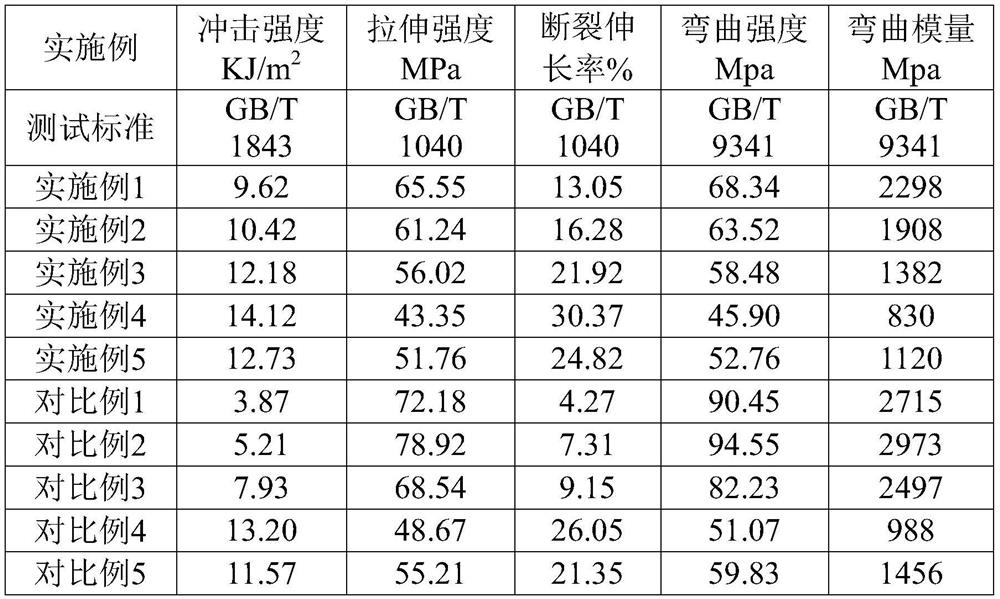Copolymerization toughening modified material for 3D printing PLA (polylactic acid) and preparation method of copolymerization toughening modified material
A toughening modification and 3D printing technology, which is applied in the directions of additive processing, climate sustainability, sustainable manufacturing/processing, etc., can solve the problem that the long-term stability of toughening cannot be guaranteed, the printing process has poor fluency, PLA Poor toughness and other problems, to achieve the effect of good drawing effect, stable size, no warping and brittle fracture
- Summary
- Abstract
- Description
- Claims
- Application Information
AI Technical Summary
Problems solved by technology
Method used
Image
Examples
Embodiment 1
[0036]Take 85 parts of pre-dried PLA 4032D, 10 parts of TPU 1816, 0.5 part of BASF ADR4368CS, 0.1 part of diglycidyl ether, 0.25 part of lubricant stearic acid and polyethylene wax, 0.25 part of calcium zinc stabilizer, silane coupling 5 parts of talcum powder treated with the agent was put into a high-speed mixer and mixed for 15 minutes. After mixing evenly, it was melted and extruded by a twin-screw extruder, and water-cooled and pelletized. The processing temperature of the 8 zones of the twin-screw extruder was 160°C in turn. , 170℃, 180℃, 190℃, 200℃, 200℃, 200℃, 190℃, the screw speed is 170r / min, the feeding speed is 5.0r / min, and the main engine current is 13.8A.
[0037] The obtained modified particles were dried in a vacuum drying oven at 80°C for 4 hours, and the moisture content was measured to be less than 0.1%, taken out, poured into the hopper of a single-screw extruder, and melted and extruded into filaments with a diameter of 1.75 mm, wherein The processing tem...
Embodiment 2
[0039] Take 80 parts of pre-dried PLA 4043D, 15 parts of TPU 5887ARE, 1 part of PPGDGE, 0.2 part of 1,4-cyclohexanedimethanol diglycidyl ether, 1,4-cyclohexanedimethanol diglycidyl ether diacrylate 0.3 part of lubricant stearic acid and 0.25 part of silicone powder each, 0.25 part of lead salt stabilizer, 5 parts of calcium carbonate treated with silane coupling agent, put into a high-speed mixer and mixed for 15 minutes, mixed evenly and passed through a twin-screw The extruder is melt-blended and extruded, and water-cooled pelletizing. The processing temperature of the 8 zones of the twin-screw extruder is 160°C, 170°C, 180°C, 190°C, 200°C, 200°C, 200°C, and 190°C. The rotating speed is 180r / min, the feeding speed is 5.0r / min, and the main machine current is 13.5A.
[0040] The obtained modified particles were dried in a vacuum drying oven at 80°C for 4 hours, and the moisture content was measured to be less than 0.1%, taken out, poured into the hopper of a single-screw extr...
Embodiment 3
[0042] Take 75 parts of pre-dried PLA 510, 20 parts of TPU 1198ARE, 10.8 parts of bisphenol A epoxy resin E5, 0.3 part of ethylene glycol diglycidyl ether, 0.25 part of lubricant silicone powder and 0.25 part of polyethylene wax. Oxygen 1010 and 168 each 0.25 parts, 5 parts of wollastonite treated with silane coupling agent, put into a high-speed mixer and mixed for 15 minutes, after mixing evenly, melt-blending and extruding through a twin-screw extruder, water-cooled pelletizing, Among them, the processing temperature of the 8 zones of the twin-screw extruder is 160°C, 170°C, 180°C, 190°C, 200°C, 205°C, 200°C, 195°C, the screw speed is 200r / min, and the feeding speed is 6.0r / min. , the host current is 13.1A.
[0043] The obtained modified particles were dried in a vacuum drying oven at 80°C for 4 hours, and the moisture content was measured to be less than 0.1%, taken out, poured into the hopper of a single-screw extruder, and melted and extruded into filaments with a diamet...
PUM
 Login to View More
Login to View More Abstract
Description
Claims
Application Information
 Login to View More
Login to View More - R&D
- Intellectual Property
- Life Sciences
- Materials
- Tech Scout
- Unparalleled Data Quality
- Higher Quality Content
- 60% Fewer Hallucinations
Browse by: Latest US Patents, China's latest patents, Technical Efficacy Thesaurus, Application Domain, Technology Topic, Popular Technical Reports.
© 2025 PatSnap. All rights reserved.Legal|Privacy policy|Modern Slavery Act Transparency Statement|Sitemap|About US| Contact US: help@patsnap.com

